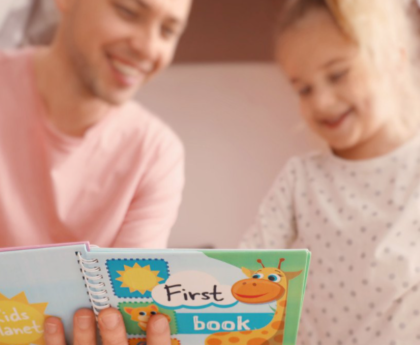Children enter literacy development long before they ever learn the alphabet song or begin sounding out simple words. In fact, language acquisition—the early foundation of reading skills—begins for infants. It’s never too early to introduce your child to the joy of reading in order to support their literacy development.
When it’s time to teach your child how to read words, it’s helpful to know the science behind reading development. Additionally, there are many great programs, online tools, and apps that can help your child build early skills at home.
Knowing what to look for in good reading programs will help you choose the best one to help your child with their reading needs. Let’s look at a few of these important features that prove to be effective.
How Children Learn to Read
One of the first reading-related skills children develop is phonemic awareness. Children learn early on that words are made of language sounds, and that these sounds have meaning. They naturally learn to mimic, manipulate, and form speech sounds as a way to communicate with those around them.
Soon into early reading development, children learn the alphabetic principle. This is the concept that text is made up of printed words, and these printed words are made up of alphabetical letters that represent sounds.
Once children learn the ABCs, they must be taught that letters (or graphemes) are written symbols for language sounds (phonemes). This is essential for learning to decode (sound out words in print).
But phonemic awareness and phonics—or applying letter-sound relationships to sounding out words—are only two beginner components of learning to read. Children must develop strong decoding skills to sound out unfamiliar words. Then, they can gradually learn to map sight words, or words that can be recognized instantly instead of sounding them out each time they’re encountered in text.
Another important aspect of reading is oral reading fluency. The more fluent a reader is, the better they understand what they are reading.
The five components (or pillars) of reading, as identified by the National Reading Panel are essential for becoming a successful reader:
- Phonemic awareness
- Phonics
- Fluency
- Vocabulary
- Comprehension
All of these pillars of reading should be part of any good reading program. On top of that, instructional methods used within the program can make or break its efficacy.
Phonemic Awareness and Phonics Skills: The Foundation
Phonemic awareness and phonics are both fundamental in learning how to read. While the terms phonics and phonemic awareness are sometimes used interchangeably, they are not the same thing.
Phonemic awareness is the ability to recognize different units of sound in words. It is being able to identify, isolate, blend, segment, and interchange the sounds in spoken words. This is an essential skill children develop over time. Having a strong grasp of phonemic awareness leads to greater success with fluent reading and spelling.
Phonics instruction involves auditory and visual skills. It is being able to match the units of sound to their corresponding letters (or combination of letters) and being able to blend letters in print to form words.
Because these two skills support other aspects of reading development, they should be the foundation of any good reading program.
What Features to Look for in an Effective Reading Program
Now that you know the foundations of learning to read, here are some specific features to look for in quality reading programs.
Systematic Phonics Instruction
Learning to read is a continual process, which means kids must explicitly learn new skills that build on top of previously-learned skills. Children go through five stages of reading development on their way to reading mastery. Look for a program that is relevant to your child’s stage of reading development and can help them move systematically to the next level.
Synthetic Phonics
It is best to look for programs that use synthetic phonics. Synthetic phonics is a ‘synthesis’ of individual letters and sounds to read and spell words. This is different from analogy or analytic phonics which may use word families or comparison of whole words to teach reading and spelling. There is research to show that this is the most efficient method of phonics instruction for children.
Engaging
No matter how instructionally rigorous a reading program is, it isn’t going to benefit your child if it’s not engaging. A great reading program is both educational and fun for kids to engage in. Ideally, the program offers fun ways for you and your child to track their progress and keep them motivated.
Developed by Experts
Many reading programs help children learn and practice reading skills in isolation, but not all of them are systematically proven. A quality reading program should be developed with the help of professional educators, literacy researchers, and educational program designers who understand children and know how children learn to read.
Research-Based
As educators and scientists learn more about how the brain learns to read, pedagogical methods and frameworks evolve to meet these needs. The best reading programs are backed by science and are based on proven educational practices.
Affordable
Because of the number of easily available online reading programs and reading apps for kids, cost is another important thing to consider when choosing the best one. When you know what features to look for, you can compare and then factor in the cost of the program. Reading.com is a trusted, evidence-based educational platform for early readers that is within budget and helps parents help their children develop essential skills.
Which Reading Programs Help Struggling Readers?
Many reading programs are designed for toddlers, preschoolers, and kindergartners, offering activities that teach phonemic awareness, phonics, and other pre-reading skills. But what about older kids who struggle with reading?
For struggling students, you want to find a program that emphasizes the core components of reading. However, it’s helpful to find one that’s not designed specifically for young children. To help a school-aged child with reading skills, look for intervention programs specifically designed for struggling readers.
Whether a child has dyslexia or another learning disability, the strategies for reading intervention are often similar. The University of Florida Literacy Institute (UFLI) has excellent resources for educators teaching all young children to read well. The Dyslexia Help website offers great resources and a list of programs that can help these readers. Additionally, the International Dyslexia Association (IDA) has a good collection of supporting resources for people with learning disabilities.
Another site that lists useful apps to support older kids with reading disabilities is The Literacy Nest. For tools for struggling readers, check out Really Great Reading. If you have questions about your adolescent child’s reading, you can ask an expert through AdLit.
It’s important to note that most children can become great readers with early, quality intervention, even if they’re struggling now.
Reading.com: A Fun and Effective Learning Program for Kids
Whether your child is still developing pre-reading skills, improving their literacy knowledge, or struggling to read, Reading.com is a fun and engaging app for kids. It’s based on the science of reading and offers activities beginning with alphabetical letters and guiding kids to read decodable books. Download the Reading.com program today for a free trial!





